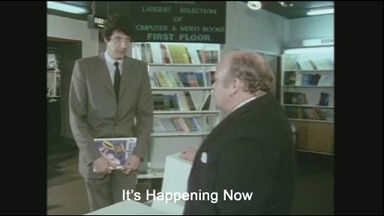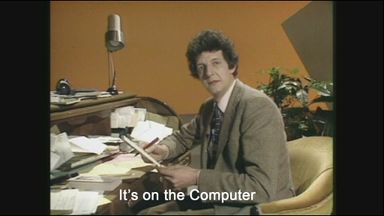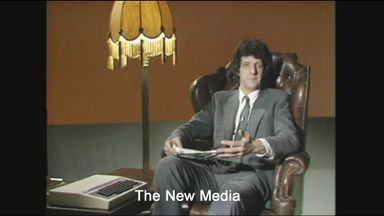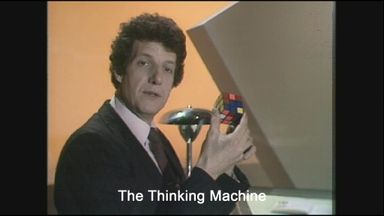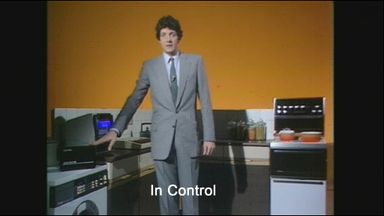The Computer Programme
4. It's on the Computer
Clips from this programme
Form filling these days is heading inexorably towards being designed to suit the computer. Computers are storing more and more information
Duration: 00:29The design of a Space shuttle is captured in a book. It's only one of many thousands of books and manuscripts Mac finds in the British Museum science library - from ancient Egyptian texts to a treatise about demise of the flush toilet. Information is growing at an incredible rate. But how to cope with it and how to find what you want?
Duration: 02:25Egyptian hieroglyphics and the Roman Alphabet are easily recognised by the human eye.
Duration: 00:41Early automatic sorting machines - for example one used for a census - find it easy to read information coded on punched cards with either a hole or nothing. One row of 8 holes represents one character - a letter or a number - one 'byte'. The machine is used here to sort people's records by age. Now we have a way of storing letters and numbers in coded form
Duration: 02:38Now we know how to store information on a chip
Duration: 00:26Finding information in the British Library's index often produces too many results. Refining a search is crucial to finding what you want.
Duration: 02:44A comparison of storage to hold ever increasing amounts of information - from the computer's internal memory via the cassette tape to disc storage and the recently developed videodisc, able to hold the whole of the Encyclopaedia Britannica. Searching a videodisc allows not just retrieved text to be displayed but also video - a glimpse into the future of multimedia information retrieval systems
Duration: 03:08Gill Nevill explores the use of a home micro- sized computer to run the hospital meal ordering system which not only improves providing patients with what they want and when they want it but also helps the chef predict what to order and how to time the cooking
Duration: 04:02Mac explains the idea of variables (in the context of a bank vault). There are numeric variables and alphabetical variables. A birthday database is created on the home micro
Duration: 05:08Rex Malik predicts that as the cost of storage becomes trivial, more and more information will be held in computers outside the home with the potential for misuse of the vast amounts of data held in computers in the future. But reminds us of GIGO - "Garbage in, garbage out"
Duration: 01:24The Computer Programme
1. It's Happening Now
First broadcast: 11th January 1982
Duration 24:51
"Don't expect the computer revolution to happen tomorrow, it's going on all around us." Chris Serle, Ian McNaught-Davis and Gill Nevill begin their exploration of the world of Information Science and ask: 'What can computers do for us? Who is using them now, and where is this technology likely to lead?' Director: FRANK ASH Director: MATT BONEY Producer: PAUL KRIWACZEK
2. Just One Thing After Another
First broadcast: 18th January 1982
Duration 24:53
CHRIS SERLE, IAN MCNAUGHT-DAVIS and Gill Nevill, continue their exploration of the world of information science. Even the most elaborate and sophisticated computer programs are made up of only a few types of relatively simple steps. The art of computer programming lies in combining these into ever more complex combinations. Directors FRANK ASH, MATT BONEY Producer PAUL KRIWACZEK
3. Talking to a Machine
First broadcast: 25th January 1982
Duration 24:23
CHRIS SERLE, IAN MCNAUGHT-DAVIS and GILL NEVILL continue their exploration of the world of information science. The difficulty of communicating with computers is that they are machines and we are people. The common language we share can turn out to be a lot more like English than we might expect. Directors FRANK ASH, MATT BONEY Producer PAUL KRIWACZEK
4. It's on the Computer
First broadcast: 1st February 1982
Duration 24:39
CHRIS SERLE, IAN MCNAUGHT-DAVIS and GILL NEVILL continue their exploration of the world of information science. Storing information is what the great majority of computers are used for. But how much can they hold, and how can the stored information be easily retrieved? Director MATT BONEY Producer PAUL KRIWACZEK
Now playing
5. The New Media
First broadcast: 8th February 1982
Duration 24:12
CHRIS SERLE, IAN MCNAUGHT-DAVIS and GILL NEVILL continue their exploration of the world of Information Science. 5: The New Media : The greatest public impact of information technology is likely to be in the provision of new means of communication. Directors FRANK ASH, MATT BONET Producer PAUL KRIWACZEK
6. Moving Pictures
First broadcast: 15th February 1982
Duration 24:37
CHRIS SERLE, IAN MCNAUGHT-DAVIS and GILL NEVILL continue their exploration of the world of information science. For many people games, with their elaborate visual displays, are the most commonly encountered aspect of computer technology. But generating sound and pictures from a computer is no different to manipulating text. Director: MATT BONEY Director: Frank Ash Producer: PAUL KRIWACZEK
7. Let's Pretend
First broadcast: 22nd February 1982
Duration 24:32
CHRIS SERLE, IAN MCNAUGHT-DAVIS and GILL NEVILL continue their exploration of the world of information science. 7: Let's Pretend: Training space-shuttle pilots, or testing bridges to destruction, is normally too costly or too dangerous to do on the real thing. But by giving a computer an exact description of how a complicated system behaves, it can mimic anything from the British economy to the world's weather. Directors FRANK ASH, MATT BONEY Producer PAUL KRIWACZEK
8. The Thinking Machine
First broadcast: 1st March 1982
Duration 24:30
CHRIS SERLE, IAN MCNAUGHT-DAVIS and GILL NEVILL continue their exploration of the world of information science 8: The Thinking Machine: In spite of years of investment in the development of intelligent machines, computer scientists are still a long way from equalling human thought, let alone surpassing it. The future, however, may yet present us with great surprises. Directors MATT BONEY, FRANK ASH Producer PAUL KRIWACZEK
9. In Control
First broadcast: 8th March 1982
Duration 24:34
CHRIS SERLE, IAN MCNAUGHT-DAVIS, GILL NEVILL 9: In Control: By far the greatest number of computers with which we will come into contact in the future will be invisible. They will be the microprocessors built into many of our domestic appliances, replacing many of the mechanical systems that we use today, with greatly improved reliability, flexibility, and at low cost. Directors FRANK ASH, MATT BONEY Producer PAUL KRIWACZEK
10. Things to Come
First broadcast: 15th March 1982
Duration 24:17
CHRIS SERLE, IAN MCNAUGHT-DAVIS and GILL NEVILL continue their exploration of the world of information science. Things to Come: Information technology has the power to change the face of our society completely by taking over the work of a large majority of the population. But will this be allowed to happen, and which aspects of our economic life are most likely to be affected? Directors MATT BONEY, FRANK ASH Producer PAUL KRIWACZEK












